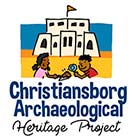At Christiansborg Castle, a community that embodied the complexity of the transatlantic slave trade is being uncovered by descendants of those who created it.
Along a stretch of the West African coast known to European explorers and traders as "White Man's Grave" due to its association with death from malaria, yellow fever, dengue, and heat exhaustion, Danish soldiers and merchants built a fortified structure called Christiansborg Castle in 1661. The building survives to this day in what is now the city of Accra, Ghana, where it is known as Osu Castle, after the district in which it stands. Since 2014, archaeologists led by Christiansborg Archaeological Heritage Project director Rachel Ama Asaa Engmann have been working at the castle. They have uncovered evidence of a Euro-African community made up of European men who worked at the castle, African women they married, and the children of their unions. The primary business in which this community was engaged was the transatlantic slave trade. With only a few brief interludes, from the construction of the fort until 1803, when Denmark began to enforce its abolition of that trade, an estimated tens of thousands of enslaved people were held in Christiansborg Castle's dungeons before being taken to the Danish West Indies, which included the Caribbean islands of Saint Croix, Saint John, and Saint Thomas. At least 100,000 captives were transported during the Danish transatlantic slave trade.
November/December 2021






